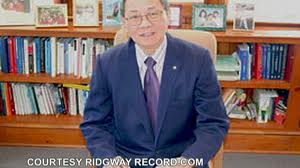Diplomat’s book dedicated to Filipinos who care about their heritage

By Loida Nicolas Lewis
Ambassador Virgilio A. Reyes Jr. retired from the Philippine diplomatic corps at the mandatory age of 65, in 2014, after 35 years of service.
But luckily for us living in these troubled times, he released his book, “A Memory of Time” before the year 2020 ended. In the words of Gemma Nemenzo who writes the Prologue: “It is a book that will benefit everyone who cares about our homeland’s heritage from which our collective soul soars.” A book we need to remind us how much we miss our beloved home country the Philippines.
Some of the essays in the book were previously published in the Philippine Daily Inquirer Lifestyle section in a column called “Salamisim” (Reflections) as well as in Positively Filipino. Some are original and published for the first time here in a scintillating brew.
I met Ambassador Virgil almost the same time when he joined the Foreign Service because his wife Marie Luarca Reyes was a classmate of my sister Imelda “Mely” Nicolas at St. Theresa’s College. I was two years their senior at STC. I would meet the Ambassador at social and cultural events in New York and in Manila and we would have the occasion to discuss salient developments in the Philippines.
Like his wife Marie, his elder sisters Cynthia and Georgina were also graduates of STC Manila, an institution which had produced writers and committed Filipino citizens. Virgil has shared with me the humorous note that he had been a Theresian for one year when he was a Grade One student and STC still accepted boys. He was a classmate of Renato Corona who would become the 23rd Chief Justice of the Supreme Court of the Philippines. They were part of what became known as “Mother Redempta’s Boys.”
The title of his book, “A Memory of Time,” was borrowed from the Roman poet Virgil: “No day shall erase you from the memory of time.”


His writings in Part 1 took me on his travels to Cape Town, South Africa where he discovered, among other things, that Filipinos had established a fishing colony in the 1860s and that their descendants still lived there. Here, he met notable personalities, such as Nelson Mandela who was the Nobel Peace Prize recipient for 1993 and Bishop Desmond Tutu who received the same honor in 1984.
He met Fidel Castro when he was working with the Philippine Mission to the United Nations and attended a meeting of the Non-Aligned Movement on Disarmament in Havana, Cuba in 1988. He writes about his impression of Aung San Suu Kyi upon her release from house arrest in 1995, when he was assigned in Yangon, Myanmar. He visited the fabled Rick’s Cafe in Casablanca, Morocco, where the movie with Humphrey Bogart and Ingrid Bergman played 24/7.
Part 2 of his book extensively describes the impact on Philippine culture and arts of illustrious artists and personalities such as The Incredible Nick Joaquin; NYC dancer, author, and culinary expert Ronnie Alejandro; classical guitarist Michael Dadap, who is the music director and conductor of the exquisite Children’s Orchestra Society (a school he runs with his wife Dr. Yeou-Cheng Ma); another STC graduate Therese Rodríguez, who is head of the Asian & Pacific Islander Coalition on HIV/AIDS or APICHA; his late father Virgilio Reyes Sr., who was Press Secretary to President Diosdado Macapagal and news editor of the Manila Chronicle. Esteemed journalist colleagues Johnny Gatbonton and Rosalinda Orosa paid his father a moving tribute in the book.
Virgil and his four siblings were already adults when their father passed away from a heart attack at 55, but they continued his tradition of writing and communication. His sister Georgina was dean of the UP Institute of Mass Communication while their mother Erlinda Alcantara-Reyes was chairman of the UP Department of Speech and Drama. Their grandmother Esther Tempongko-Alcantara had been an English professor at the Far Eastern University to such notables as Kerima Polotan-Tuvera. Writing and communication are truly in their blood.
Part 3 of the book includes a review of the Philippine Gold Exhibit held at Asia Society from September 2015 to January 2016. It was the most attended exhibition in the history of the museum, the first time that gold products produced in the 12th to 13th century before Spain’s colonization of the Philippines were exhibited in the United States.
Part 4 of the book are the Ambassador’s own reviews of books he has read and Broadway shows he has seen.
Part 5 of the book contains the author’s own reflections about the Philippine historical places: the Walled City of Intramuros; Quiapo, which is now becoming a Mindanao enclave; the historic house belonging to the author’s ancestors in Maragondon, Cavite where Andres Bonifacio was sentenced to death in a kangaroo court.
The author has also written a heartwarming tribute to his mother Erlinda Alcantara Reyes, who raised her five children for the next 20 years after her husband died.
I encourage everyone to read “A Memory of Time” one article at a time and let its clarity of observation wash over you after reading each essay. The Ambassador is truly one erudite, articulate, profound, and insightful writer.
“A Memory of Time” is available at Amazon.com.
© The FilAm 2021











